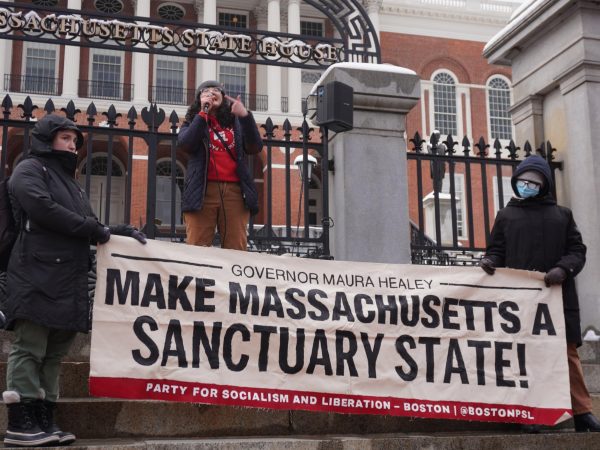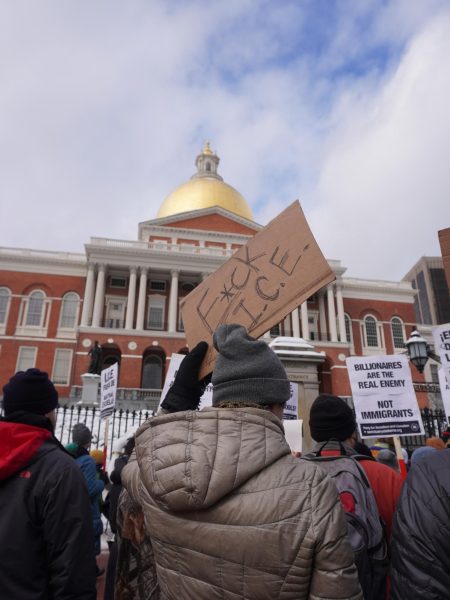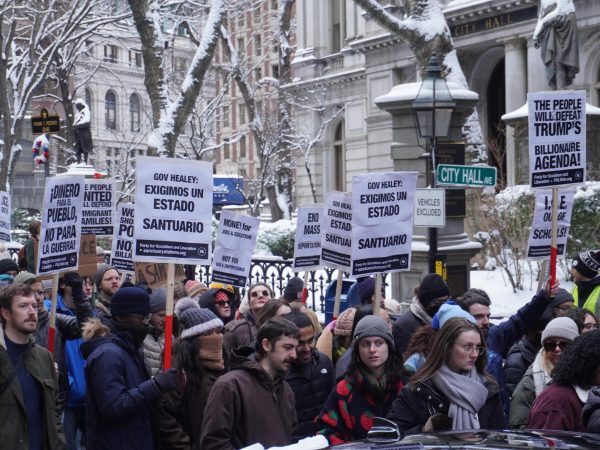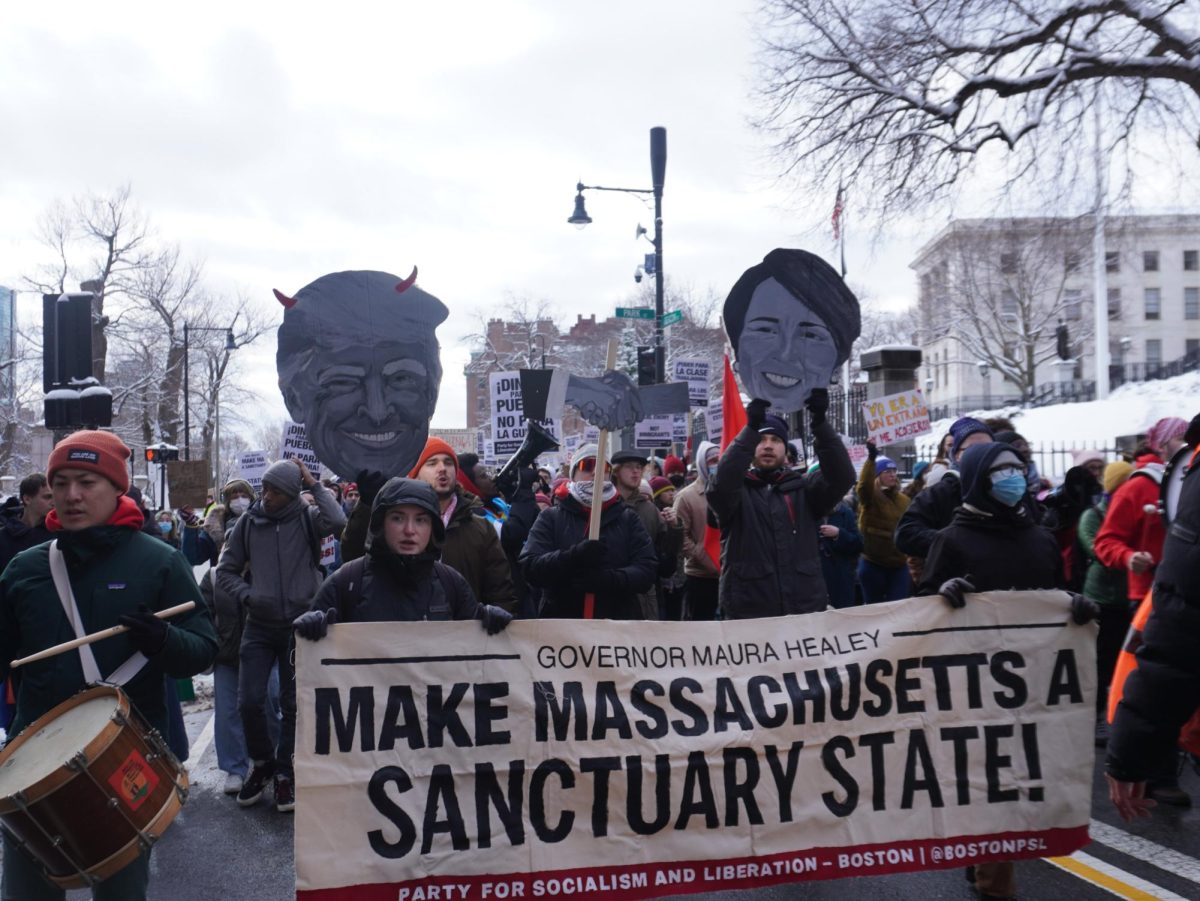“Officials here follow the law. We are not a sanctuary state,” said Massachusetts Gov. Maura Healey in a January press conference, in response to President Donald Trump’s recent changes to federal immigration policy.
The Party for Socialism and Liberation, or PSL, rallied Boston residents before the Massachusetts State House Feb. 9 to protest the governor’s statement and demand protection for the city’s immigrant communities. Chants, cheers and declarations of shame pierced the snow-chilled air as over 300 people gathered in support of Boston’s immigrants.
“The public opinion of Massachusetts is that it’s a very progressive state, and it’s a shame that she’s [Healey] not fighting harder against Trump’s clear campaign against immigrants,” said Jocelyn Santiago, an East Boston resident and PSL organizer. “We elect these officials into office, and they should be beholden to what we as constituents are asking for, and that’s what this campaign is pushing her into doing: the right thing.”
With Trump’s immediate and vast crackdown on immigration — deploying U.S. Immigration and Customs Enforcement, or ICE, across the country and signing 10 executive orders relating to immigration — many living in states with substantial undocumented immigrant communities, like Massachusetts, are concerned with how these policies will affect them and those they care about.
“I am pretty filled with dread and fear about the new administration, and I feel it’s important to organize and to defend everybody who is targeted under it,” said Jesse, a student at Lesley University who asked his last name be omitted for safety purposes. “I’m trans, so I’ve already been targeted as a group, but immigrants, and especially immigrants from Central America and South America, are very targeted and they’re experiencing a lot of oppression, being singled out as America’s kind of scapegoat; we should defend them because if they come for them, they come for us.”
The term “sanctuary state” is loosely defined. According to the American Immigration Council, within an established sanctuary state, state and local officials maintain limited cooperation with federal immigration authorities. While the state cannot actively prevent federal officials from carrying out immigration enforcement, it is within their legal right to resist federal law enforcement by withholding information from federal immigration officers.
Massachusetts is home to many sanctuary cities, including Boston, housing a significant immigrant population with a notable contribution to the state’s labor force and economy. As of 2023, immigrants made up 18.1% of the population in Massachusetts — but with the recent flurry of executive orders, there is political pressure on local officials to comply with Trump’s policies.

“My opinion on the matter is that she’s [Healey] afraid of becoming a target of the Trump administration; they’ve made it very clear that they’re going to go after anybody who ‘stands in the way of their mass deportation plan,’ and the lack of courage on her part is extremely disheartening,” Santiago said.
Healey asserted that Massachusetts has never been a sanctuary state, but many residents disagree. The general confusion surrounding whether or not the state has sanctuary status is, in part, due to the “Right to Shelter” law. The law was adopted 40 years ago to provide housing for families in need, specifically pregnant women and homeless children. Massachusetts is the only state in the country with such a guarantee, and its interpretation is highly contested, with families from all over the world seeking a home in Massachusetts.
“It is widely believed that Massachusetts is, in fact, a sanctuary state, and it’s not,” Santiago said. “[Healey]’s been making it extremely clear that it’s not, that’s been her presence in the media lately.”
Last month, Healey proposed systemic changes to the “Right to Shelter” law that would remove protections for immigrant families, attempting to redefine the law toward its intended purpose.
Disappointment with Healey’s public declaration was palpable among the Bostonians who took to the streets and voiced their discontent.
“I’d like an [state] executive order to be signed to make Massachusetts a sanctuary state,” said Jose Betances, a student at Massachusetts Institute of Technology. “My home state, New York, did that; Washington’s done that; there’s no reason Massachusetts can’t do that. We need to make an immediate impact and protect undocumented immigrants from ICE raids, protect them from deportations and protect them from the concentration camps being made in Guantánamo Bay.”
Signs reading “No human is illegal” and “Get ICE off the streets” were held high by an impassioned crowd of primarily young adults. Several musicians played jovial rhythms, punctuating chants with the steady beat of a drum or the blow of a trumpet.

Three speakers, who all omitted their last names, individually addressed the crowd outside the State House in both English and Spanish. The speakers empowered the protesters and emphasized the need for political action from the community — met with cheers or a collective “Shame!” shouted from the mass of ralliers.
The speeches held both Democrats and Republicans accountable for the controversial immigration laws sweeping the nation. They called for the state’s workers to organize and fight against the divestment and abandonment of statewide immigrant protections. In the fearful political climate many Boston immigrants are currently living in, the speakers sought to unite their supporters by laying out and heavily stressing what the PSL specifically wants to see from local lawmakers.
The PSL and its collaborators’ goals are outlined in four demands that speakers heavily stressed: No state or local police collaboration with ICE; ending the racist rhetoric surrounding immigration; no more restrictions on housing and preventing ICE raids in all Massachusetts public institutions, including schools.
All four demands rest atop the desire for Massachusetts to be a sanctuary state — the overarching goal of the rally.
“We need a strong and unambiguous stance against the deportations that have been happening, a strong and unambiguous stance against the horrifying and dehumanizing policies that the Trump administration is instating in America and for local governments to take a stand,” Jesse said.
A top priority at the rally was preventing ICE from entering schools. Many protesters worked in education and cited students’ fear of deportation as a recent and consequential issue in classrooms across the state.
“I am an immigrant,” said Suseth Muñoz, a teacher in Dorchester. “I am fortunate enough that I am a naturalized citizen now, but I come from a border town, so every single policy that President Trump is unleashing has a direct impact on my community back home, and that doesn’t change here, now that I’m a teacher.”
Educators have voiced that the constant threat that ICE may appear in a classroom is not conducive to learning. Muñoz said her students worry that they or their friends will be deported, even in spaces previously thought of as safe, like school.
“I teach for my primarily Black and brown students and a lot of my kids do mention the things that are going on and all of the fear that they have,” Muñoz said.

Anxiety around ICE in America’s classrooms has increased since the Trump administration reversed a longstanding policy that directed immigration agents to avoid sensitive locations such as schools and churches. The idea of school ICE raids has been met with controversy, especially among teachers.
“I would love to see Maura Healey approve a sanctuary state, I think it would really help our communities and our families that bring our students to school every day,” said Maria Ordoñez, a university employee at Boston College. “I think it would make a huge difference and make it so that students actually feel safe at school.”
The speakers then mobilized the crowd to march. Protesters poured into the street, chanting steadily as they wrapped around the State House and continued down School Street.
“We’re also both immigrants coming from immigrant families, and if the state isn’t going to defend us, then we’re going to defend ourselves,” Ordoñez said.
“We want justice, you say, ‘How?’; stop the deportations now!” Rang through the streets and into the ears of passersby as the crowd continued their march past Boston’s old City Hall and gathered once more in front of the current City Hall.
The rally continued in front of City Hall, where the band kept spirits high and two final speakers reminded protesters of the U.S. government’s role in forcing people all over the world from their home countries.
The speakers concluded with a call to action, urging everyone to continue to organize, sign the petition to make Massachusetts a sanctuary state and be heard standing up for the immigrant community. The crowd dispersed with the final sentiment that this movement is nationwide, that, beyond Boston, the entire country is standing together and saying that this is only the beginning.










![A demonstrator hoists a sign above their head that reads, "We [heart] our international students." Among the posters were some listing international scientists, while other protesters held American flags.](https://huntnewsnu.com/wp-content/uploads/2025/06/image12-1200x800.jpg)

